D&D Monster Monday: Drider
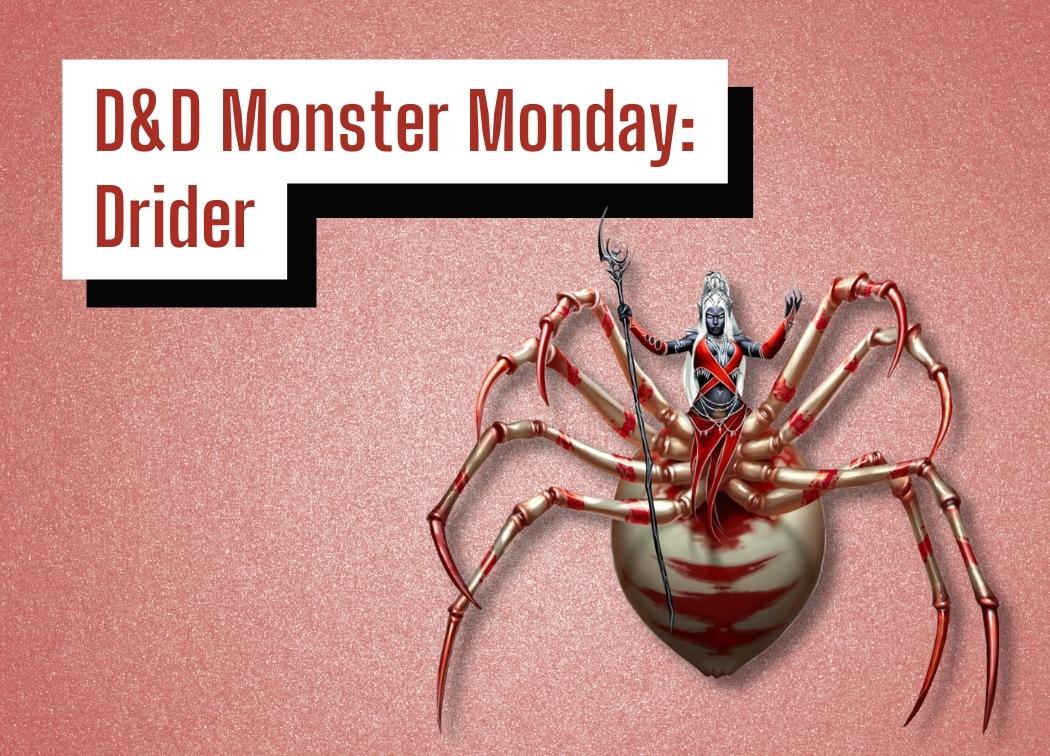
Darkness envelopes you as you travel through this tunnel in the middle of the Underdark. Your lit torch cannot permeate this magical darkness. You frantically run further into the cave. Finally, you can see again. Suddenly you feel a succession of 3 sharp arrows sink into your back. Poison seeps into your veins. You turn around to see a drider skittering down from the ceiling, laughing maniacally as they draw their sword to finish the job.
This week has unofficially, officially become “Underdark Week” since I have immersed myself in this setting due to a one-shot my group will be finishing today. A review of said module will be coming this Friday!
In light of that, I wanted to highlight one of the creatures in the module that was full of Underdark monstrosities and drow. I couldn’t decide between a monstrosity or a drow, though, so I decided to go with both!
The drider is a hybrid creature like a centaur. They are drow that were cursed by the Spider Queen, Lolth, and transformed into half spider/half drow monstrosities. Driders are both terrifying to deal with in combat and terrifying in general.
You can also find the drider’s statblock on page 120 of the 5e Monster Manual
Drider Lore
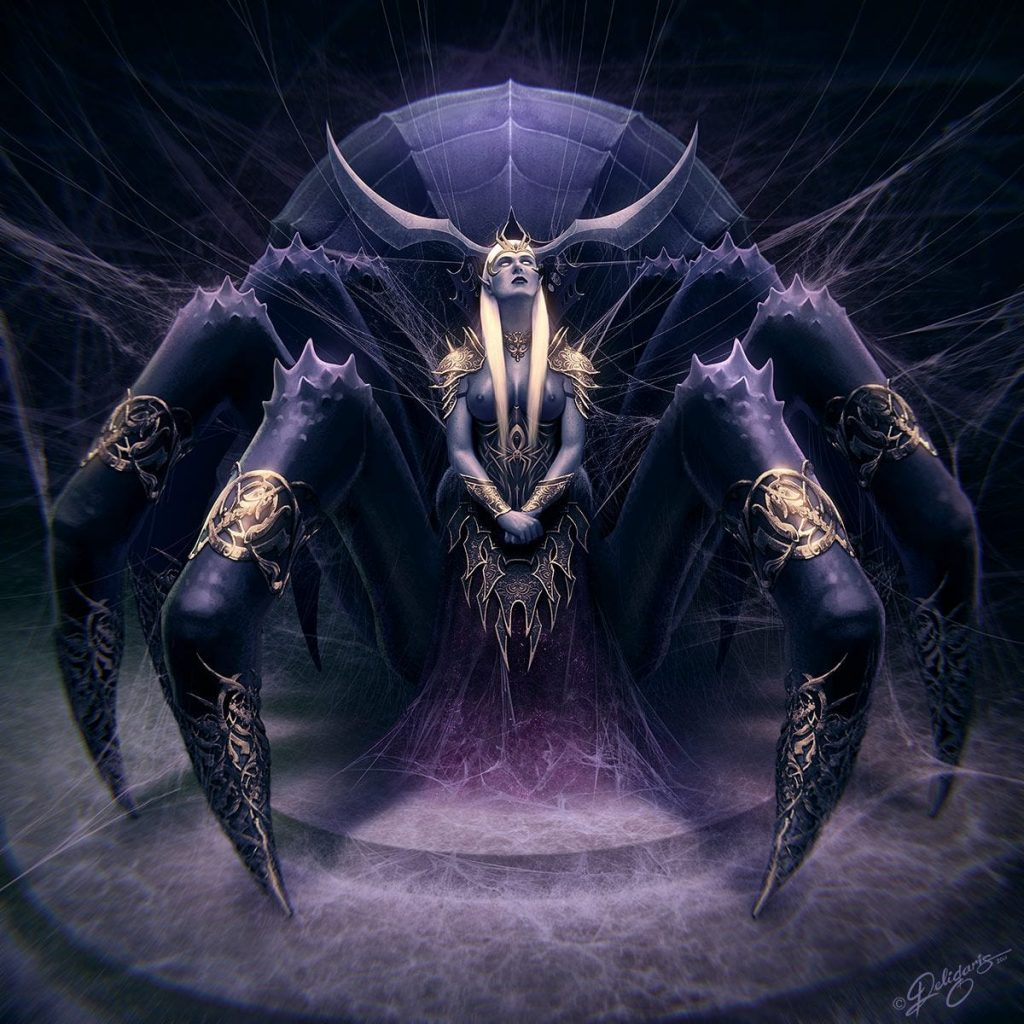
In drow society a select few drow will be seen as promising by Lolth and will be summoned to her domain, the Demonweb Pits. These drow will be tested in both their faith in Lolth as well as their physical strength and prowess. As with everything involving Lolth there is a catch to this test.
Drow that pass the test will rise even higher in Lolth’s favor. This will further their prestige in drow society and plenty of perks will come with being in Lolth’s favor. The risk, however, is that if a drow fails this test they are transformed into a drider, forever.
Driders are then sent back into the material plane and forced to live their lives in exile from drow society. They are both physically twisted and mentally broken and typically descend into madness. A drider will typically make way further into the Underdark and live out the rest of their miserable life as a hermit or a wanderer.
The MM does note that there are exceptions to this rule. It’s possible for a drider to overcome their madness and be welcomed back into the fringes of drow society. Here they serve as a reminder to drow of the power of Lolth. They’d still be considered lesser and a monster by the drow, but it’s certainly better than residing in the depths of the Underdark.
In some cases driders are used in the service of Lolth or her priestesses to guard sacred grounds or other areas or items of significance to Lolth. This may be under the guise of Lolth promising to reverse the curse, but unfortunately for them, she never will.
Drider’s Stats and Abilities
Base Stats
- Size: Large
- AC: 19 (Natural Armor)
- Hit Points: 123 (13d10 + 52)
- Speed: 30 ft., climb 30 ft.
- STR: 16 (+3)
- DEX: 16 (+3)
- CON: 18 (+4)
- INT: 13 (+1)
- WIS: 14 (+2)
- CHA: 12 (+1)
The drider has an extremely great stat block. 123 HP is average to above-average for a CR 6 creature. However, 19 AC is well above average. Couple this with its climb speed allowing it to maneuver inside of caves and the jagged rocks of the Underdark and you have a very difficult to hit creature.
One thing to keep in mind though is that it is a large creature meaning it will have a much larger hitbox. However, this does mean that they’re unable to be grappled by small-sized PCs.
As far as its ability scores are concerned, the drider has a pretty strong spread. Its lowest abilities are Charisma and Intellect which are arguably the least useful for creatures. Its Dexterity and Strength are both 16 which helps showcase that this is going to be a versatile creature with a few different avenues of attack. The drider’s Constitution, as well as Wisdom, are +4 and +2 respectively which will be valuable in making saving throws against crowd control spells and abilities.
Resistances, Immunities, Saves, and Skills
- Skills: Perception +5, Stealth +9
- Senses: darkvision 120 ft., passive Perception 15
- Languages: Elvish, Undercommon
- CR: 6
Driders make for excellent ambushers with their +9 to Stealth checks they can meld into the shadows with ease. Their +5 to Perception checks and 120 ft. of darkvision helps them see their quarry from a far distance, typically well before they’ll ever be able to see the drider.
Its Elvish and Undercommon languages are nothing to be surprised about. These are the two languages they most likely spoke before they were transformed into driders. This does make it more difficult for a party to get information out of them as they do not speak Common.
Abilities and Traits
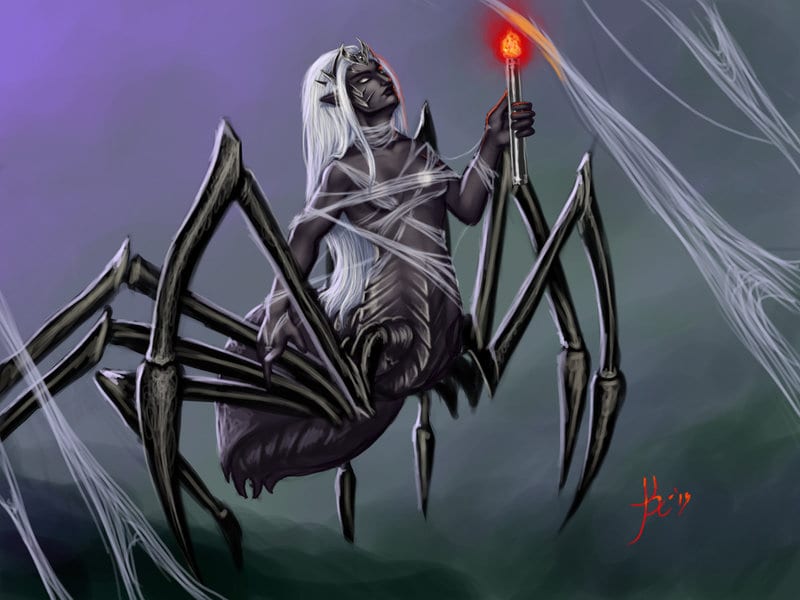
Fey Ancestry.The drider has advantage on saving throws against being charmed, and magic can’t put the drider to sleep.
Innate Spellcasting. The drider’s innate spellcasting ability is Wisdom (spell save DC 13). The drider can innately cast the following spells, requiring no material components:
At will: dancing lights
1/day each: darkness, faerie fire
Spider Climb. The drider can climb difficult surfaces, including upside down on ceilings, without needing to make an ability check.
Sunlight Sensitivity. While in sunlight, the drider has disadvantage on attack rolls, as well as Wisdom (Perception) checks that rely on sight.
Web Walker. The drider ignores movement restrictions caused by webbing.
There’s a lot to keep track of here while you’re in combat, but this is where the drider really stands out as a creature. They have the best of both worlds; the spellcasting and fey ancestry abilities of the drow and the ability to climb upside down on the ceiling and ignore movement restrictions caused by webbing like a spider.
They also have a dash of spellcasting albeit at a pretty low spell save DC. Regardless, darkness and faerie fire can both be used to help the drider control the battlefield.
If their target(s) are in an inopportune position they can cast darkness in that area and force them to move. If they are with other driders or other Underdark creatures they can cast faerie fire on their quarry and potentially grant advantage to their allies’ attacks.
In theory, Sunlight Sensitivity is a major drawback for the drider. However, in practice, I can’t imagine many scenarios that would make sense for a drider to be subject to sunlight.
They tend to stay deep within the Underdark or in the outer parts of drow society in which sunlight is never present. Mechanically it won’t see much use. This is mostly a flaw that carried over by their drow origin to add flavor to the creature.
Actions
Multiattack. The drider makes three attacks, either with its longsword or its longbow. It can replace one of those attacks with a bite attack.
Bite. Melee Weapon Attack: +6 to hit, reach 5 ft., one creature. Hit: 2 (1d4) piercing damage plus 9 (2d8) poison damage.
Longsword. Melee Weapon Attack: +6 to hit, reach 5 ft., one creature. Hit: 7 (1d8 + 3) slashing damage, or 8 (1d10 + 3) slashing damage if used with two hands.
Longbow. Ranged Weapon Attack: +6 to hit, range 120/600 ft., one target. Hit: 7 (1d8 + 3) piercing damage plus 4 (1d8) poison damage.
While the drider is perfectly capable of fighting in melee range they deal better damage with their longbow. In melee, you’d be able to do 1 bite attack and 2 longsword attacks which is 25 – 27 depending on which longsword attack the drider uses. With their longbow attack, they’ll deal 33 damage on average between 3 attacks.
Ranged attacks also mesh much better with the drider’s abilities. They can stand upside-down on the ceiling and peg their targets from below. Any melee target will have a difficult time trying to force them down from their perch, and they can even potentially give themselves advantage with Faerie Fire.
Despite all this, 25-33 damage is still fairly low for a CR 6 creature without any AoE damage spells or abilities. This is also between 3 separate attacks which of course increases their chances of missing at least one of those attacks each round.
Variant: Drider Spellcasting
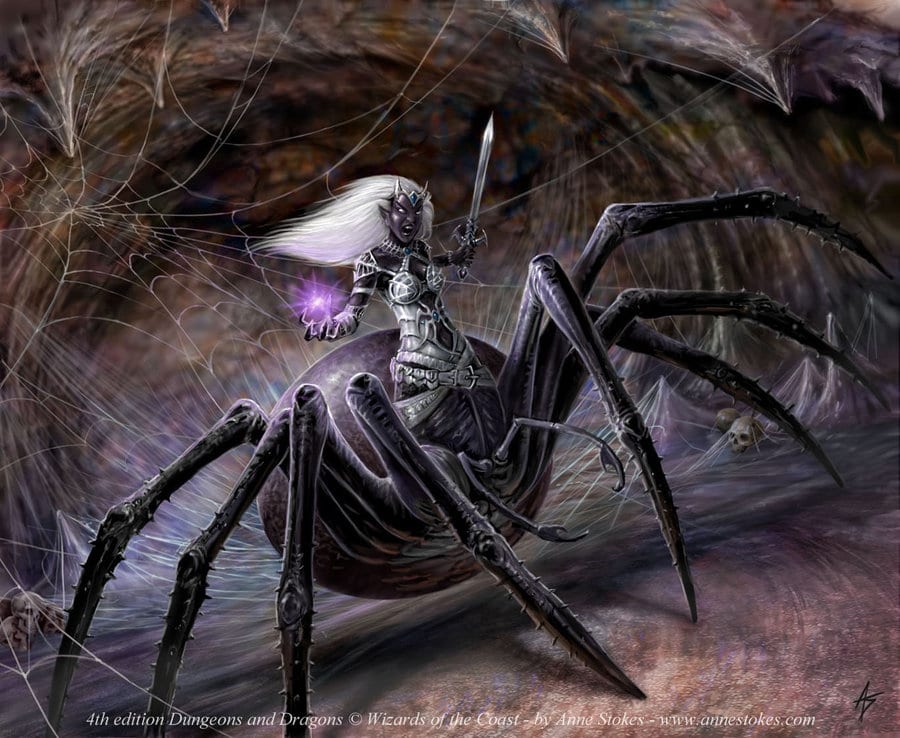
Some drow were once spellcasters before they became driders. These driders have the ability to cast more spells than the average drider and also have a higher Wisdom ability (15 or 16).
Spellcasting. The drider is a 7th-level spellcaster. Its spellcasting ability is Wisdom (spell save DC 14, +6 to hit with spell attacks). The drider has the following spells prepared from the cleric spell list:
Cantrips (at will): poison spray, thaumaturgy
1st level (4 slots): bane, detect magic, sanctuary
2nd level (3 slots): hold person, silence
3rd level (3 slots): clairvoyance, dispel magic
4th level (2 slots): divination, freedom of movement
The interesting part about this variant is that the drider’s CR remains unchanged. This comes with +1 or +2 to an ability score and 7th-level spellcasting. It’s certainly surprising that the CR is unaffected because of this.
Regardless, this list is quite awesome. The spells are all useful in and out of combat, and they stay true to the drider’s theme of reconnaissance and ambushing.
Crowd control spells like Hold Person and Silence help them to hinder their targets. Spells like Dispel Magic and Freedom of Movement both work as anti-crowd control tools.
I particularly like the inclusion of detect magic, clairvoyance, and divination which all help the drider gather information on their targets prior to a fight even breaking out. Driders may be insane, but they are absolutely brutal killers and assassins.
The Drider’s Strengths
The drider’s statblock revolves around drawing out the fight. The longer they can survive the more likely they are to take down the party. They do not have a very high damage output so they rely on their mobility and superior defenses to draw out the fight and force the party to waste valuable resources.
Even if the party fells the drider they’ll have to deal with plenty of other Underdark abominations in whatever cave or temple they were guarding. Wasting a spell on a pair of driders could be their demise, and the driders are happy to take the hit in the service of Lolth.
Maneuverability and Control of the Battlefield
While 30 ft. of movement speed is average, the drider is able to utilize this to its fullest potential. Spider Climb is a unique asset that turns the battle map from a 2-D fight to a 3-D hell hole.
The party will now have to consider height and how to reach the ceiling of the cave or room that the encounter is in. Couple this with darkness and your party may lose 1 or 2 rounds just formulating a plan.
Web Walker being thrown into the mix gives the encounter even more depth. Parts of the room or the entire room can be filled with giant spider webbing similar to the spell, web.
The driders will be able to walk on the webbing without any issues. However, the party will be subject to difficult terrain and be forced to make a Dexterity saving throw if they begin their turn on the webs. This will prove to be a difficult element to conquer in the fight even if it’s a low save DC.
Between their climb speed, the ability to latch themselves onto the ceiling and webbed surfaces, and their AoE control spells the drider has an excellent grasp of their battlefield. They can maneuver themselves into positions where the party will have great difficulty following and slowly be picked off by the driders’ poisoned arrows.
High Defensive Bonuses
19 AC is nothing to scoff at even at CR 6. This is tipping to the high-end of the AC spectrum. Coincidentally the example I used in my calculating chance to hit post and even with a +9 to attack you’d only have a 55% chance to hit a creature with 19 AC.
For reference, a character with a +9 attack bonus has 20 in the respective ability score and is at least level 9 unless they have a magical weapon or a buff cast on them. A drider is basically an armored tank.
Fey Ancestry also gives the drider advantage on saving throws made against charms and they cannot be put to sleep by magic. This helps to eliminate 2 different types of crowd control spells and gives the drider some more survivability as well.
While they lack any damage resistances or immunities they still have 123 hp on average thanks to their 18 in Constitution. This is just enough to require either a lot of luck on the party’s part, or some high-level spells and abilities to take them down.
The Drider’s Weaknesses
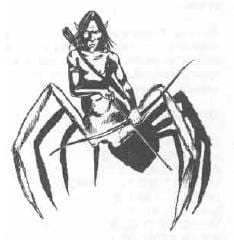
While their defensive stats and abilities can keep them in the fight long enough to soak up the party’s resources, fights still generally don’t last that long in D&D 5e. Their damage options may be versatile, but they’re still low average damage.
Lack of AoE Damaging Abilities
While they do have 3 attacks per round, driders still lack any sort of AoE damaging ability. Even their variant spellcasting type does not have any AoE damage spells in their list.
This also makes them much less threatening against larger parties. With more targets hitting them and no options to hit more than a maximum of 3 targets per round they end up not scaling very well as single creature encounters or encounters against large parties.
Low Average Damage Per Round
Their 3 attacks per round all add up to 25-33 average damage per round depending on what attacks the drider uses. This is a very low average damage per round for a CR 6 creature which doesn’t do the drider any favors.
This damage is also between 3 separate attack rolls. This means that realistically they have less of a chance of dealing that 25-33 damage in a round.
I believe the reasoning for this low damage is that driders have access to Faerie Fire. This means that if somehow multiple targets were affected by this spell they’d have 3 attacks with advantage which could very well increase the average damage per round of the drider.
How to Play a Drider
Couple this with their lack of AoE damage and we find that the drider has a pretty tough time going up against groups in terms of offensive power. Great defenses and stealth cannot make up for their lack of damage outright.
However, if you play them well and play to the drider’s strengths you will still have a pretty deadly creature. Let’s take a look at some tactics you should use when playing a drider.
3-Dimensional Fighting
Driders can hang upside-down from the ceiling with the Spider Climb trait. This will force the party to find ways to knock them off the ceiling so their melee-centric companions can deal some damage to them.
This means that the party won’t necessarily be focused on damaging the drider, or at least part of their party won’t be able to unleash their full damage potential on their foes. It helps to buy time and play to the drider’s strengths; their high AC and HP.
Spider Climb is not only useful for standing on the ceiling of a cave or large room. It also allows the drider to climb into spaces that are not easily reachable. For example, the side of a rocky mountain or chasm.
They can scale the walls of these natural rocky outcroppings and find spaces and crevices that could serve as cover from the party’s ranged attacks. This will boost their AC from 19 to 21 or 24 which makes them even more difficult to attack directly.
Control the Battlefield
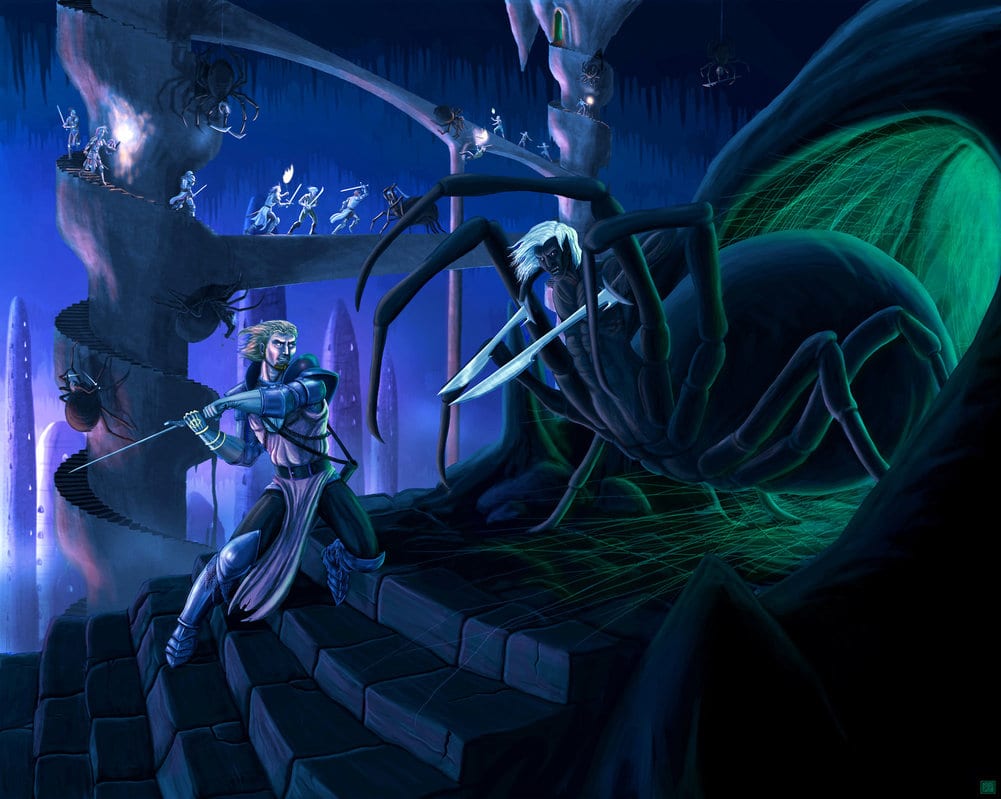
Use that +9 Stealth to potentially gain a surprise round and advantage on that initial attack with their longbow. In fact, use their longbow and keep distance between the drider and the party as much as you can. Their longbow deals more damage on average, plus it forces them to come to you and break through your 19 AC to deal damage.
This goes double for the spellcasting variant driders. They can use spells like clairvoyance and divination to scry on their prey and set up in an ideal location that the party will walk through in their journey through the Underdark.
Only a desperate drider would meet a party of adventurers in an open field. They want to use rocky outcroppings, spider webs, and ceilings of caves to make distance between themselves and their prey and stay just out of reach of melee-focused PCs.
A drider will use darkness to force the party out of safe locations or to buy them some time to gain distance, reposition, or retreat entirely.
Conclusions
While the drider does have a low average damage per round its many abilities absolutely make up for this in my opinion. A drider should not be put in a position where the party has a level playing field. A drider will engage on their terms and ensure that they’re in an area that they can thrive. Places with high ceilings and rough terrain will make for a dangerous drider encounter.
I love the lore behind the drider and drow society in general. It’s brutal and ruthless just like the Underdark. The creature is very powerful and has a lot of options in combat while not having to give up much for it.
Driders make excellent ambushers and guards for abandoned caves, temples, and other points of interest for adventurers to explore in the Underdark. They’re also a great way to introduce some of the brutality of drow society to players and show them what they’re up against in the Underdark.

I noticed a gap in Drider descriptions in the original Drow compendium and wrote the original article addressing using Driders as player characters in an article in Dragon Magazine Issue #128, “Entering the Drider’s Web” in 1987, when I was 16 years old.
I’d have to dig out my old copy to double check, but I think they copied it verbatim and added a bit more when they updated all the monster compendiums.
I just searched at random to see if my first published writing was still on the web, it warmed the heart to see it was still out there somewhere!!
Now if they would just make it possible in ONE of the video games….